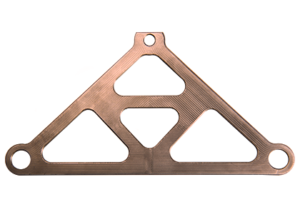Part 1 of 3.
A metal matrix composite (MMC) is a composite material with at least two parts; one typically being some desired metal, and another being a reinforcing material (typically another metal or some organic compound). When at least three materials are present, it is called a hybrid composite.
MMCs are made by dispersing a reinforcing material into a metal matrix. The reinforcement surface can be coated to prevent a chemical reaction with the matrix. For example, carbon fibers are commonly used in aluminum matrix to synthesize composites showing low density and high strength. However, carbon reacts with aluminum to generate a brittle and water soluble compound on the surface of the fiber. To prevent this reaction, the carbon fibers are typically coated with nickel, titanium boride, or some other element or compound.
The reinforcement material is embedded into a matrix. The reinforcement does not always serve a purely structural task (reinforcing the compound). It can also be used to change physical properties (such as wear resistance, friction coefficient, or thermal conductivity). And the reinforcing material can be continuous or discontinuous. Discontinuous MMCs can be isotropic and be worked with standard metalworking techniques (extrusion, forging, rolling, etc). They can also be machined using conventional techniques, but commonly need the use of polycrystalline diamond tooling (PCD).



Aluminum (left) and copper (center and right) metal matrix composites primarily used for management of thermal loads in temperature critical electrical components and structures.
Continuous reinforcement uses monofilament wires or fibers such as carbon fiber or silicon carbide. Because the fibers are embedded into the matrix in a certain direction, the result is an anisotropic structure in which the material’s properties are limited to a single direction or have different properties in different directions.
One of the first MMCs used boron filament as the reinforcing material. Discontinuous reinforcement uses “whiskers’, which are essentially short fibers or particles. The most common reinforcing material in this category are alumina and silicon carbide.
These metal matrix composite materials have seen an array of applications over the last several decades. They are often used in hybrid cutting tools, and they are frequently used in the automotive industry, aerospace industry, electronics industry (particularly in the area of semiconductors), and in a variety of military defense applications as well. MMC’s have even been introduced into the world of sporting goods. There are metal matrix composite bicycle frames, golf clubs, and tennis rackets too.
Learn more about copper and aluminum metal matrix composites from Ohio Carbon Blank.
Read Part 2: Manufacturing and Forming Methods of Metal Matrix Composites









